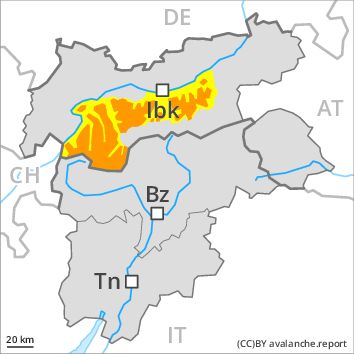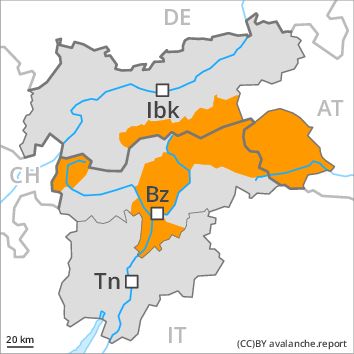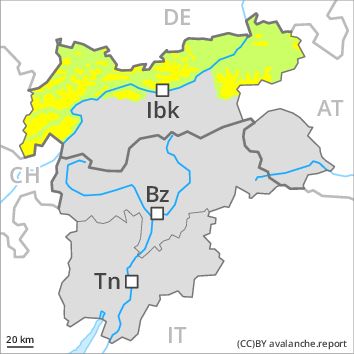Regions
Western Tuxer Alps, Eastern Tuxer Alps, Glockturm Range, Weißkugel Range, Gurgler Range, Northern Oetz and Stubai Alps

Danger level
Danger Level 3 - Considerable above 2200m
Danger Level 2 - Moderate above 2200m
Avalanche Problem
Wind-drifted snow above 2200m, N-NE-E-W-NW
Gliding snow above 2600m, N-NE-E-SE-S-SW-W-NW

Fresh wind slabs above approximately 2200 m. Below approximately 2600 m gliding avalanches and snow slides are possible.
The fresh wind slabs represent the main danger. These are sometimes thick. They can be released by a single winter sport participant in some cases especially on very steep shady slopes above approximately 2200 m, especially at transitions from a shallow to a deep snowpack, when entering gullies and bowls for example.
On steep grassy slopes more gliding avalanches and snow slides are possible, in the regions exposed to heavier precipitation especially.
Snowpack
dp 6: cold, loose snow and wind
dp 2: gliding snow
As a consequence of a strong to storm force southerly wind, wind slabs formed in the last few days at elevated altitudes. In some places wind slabs are lying on soft layers, in particular above approximately 2200 m. The snowpack will be wet all the way through at low and intermediate altitudes.
Tendency
Further decrease in avalanche danger.
Regions
Eastern Pfunderer Mountains, Durreck Range, Western Rieserferner Mountains, Val Müstair Alps, Western Deferegger Alps, Langtaufers, Central Stubai Alps, Northern Zillertal Alps, Venediger Range, Southern Zillertal Alps and High Tauern, Eastern Nonsberger Alps, Eastern Rieserferner Mountains, Northern Dolomites of Fiemme, Glockner Range, Eastern Deferegger Alps, Sarntal Alps, Schober Mountains, Western Pfunderer Mountains, Lienzer Dolomites

Danger level
Danger Level 3 - Considerable
Avalanche Problem
Gliding snow above 2600m, N-NE-E-SE-S-SW-W-NW
Wind-drifted snow above 2200m, N-NE-E-W-NW

Gliding snow represents the main danger. This applies on steep grassy slopes. Fresh wind slabs require caution, in particular above approximately 2200 m.
On steep grassy slopes more gliding avalanches are possible, even quite large ones, in the regions exposed to heavier precipitation especially, in particular in the east. This applies below approximately 2600 m.
The fresh wind slabs are in some cases still prone to triggering above approximately 2200 m, especially on very steep shady slopes and adjacent to ridgelines. The prevalence of avalanche prone locations and likelihood of triggering will increase with altitude. Large avalanches are possible in isolated cases.
Snow sport activities outside marked and open pistes call for experience in the assessment of avalanche danger.
Snowpack
dp 2: gliding snow
dp 6: cold, loose snow and wind
The snowpack will be wet all the way through at low and intermediate altitudes. In some places wind slabs are lying on soft layers, especially at high altitudes and in high Alpine regions. The sometimes strong wind will transport the fresh snow. The fresh wind slabs are in many cases thick.
Tendency
The danger of gliding avalanches will persist. The danger of slab avalanches will decrease.
Regions
Western Verwall Mountains, Eastern Verwall Mountains, Allgäu Alps, Silvretta, Samnaun Mountains, Eastern Lechtal Alps - Ammergau Alps, Mieming Mountains, Karwendel Mountains, Brandenberg Alps, Western Kitzbühel Alps, Wilder Kaiser Mountains - Waidring Alps, Eastern Kitzbühel Alps, Western Lechtal Alps, Central Lechtal Alps, Grieskogel Mountains

Danger level
Danger Level 2 - Moderate above 2200m
Danger Level 1 - Low above 2200m
Avalanche Problem
Wind-drifted snow above 2200m, N-NE-NW
Gliding snow above 2600m, N-NE-E-SE-S-SW-W-NW

Fresh wind slabs above approximately 2200 m. Snow slides in particular on steep grassy slopes.
The fresh wind slabs represent the main danger. These can be released in particular on northwest to north to northeast facing aspects above approximately 2200 m, especially adjacent to ridgelines. They are mostly small.
Slides can occur on steep grassy slopes.
Snowpack
dp 6: cold, loose snow and wind
dp 2: gliding snow
As a consequence of a strong to storm force southerly wind, rather small wind slabs formed in the last few days at elevated altitudes. In some places wind slabs are lying on soft layers, in particular above approximately 2200 m. At low and intermediate altitudes hardly any snow is lying.
Tendency
Further decrease in avalanche danger.



